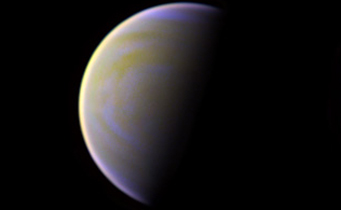Observing the Transit of Venus won’t be just a memorable experience. Astronomers hope the event will help them understand alien worlds around other stars, too.
These days, most people don’t think of sky events as scientific opportunities. Excuse for a star party, sure; reason to stop looking at your feet or your iPhone as you walk, maybe. But Venus’s upcoming transit of the Sun isn’t useful just for astronomy publicity: there are real science gains to be had, too. Among these is the chance to use our sister planet as an exoplanet proxy.

Venus's atmosphere appears strangely yellow and purple in this enhanced-color image, created by combining shots taken through ultraviolet, green, and near-infrared filters.
S&T: Sean Walker
The analog isn’t 1-to-1. An Earth- or Venus-sized exoplanet seen passing in front of a Sun-like star would cause a roughly 0.008% drop in the star’s brightness. That’s less than one-tenth the magnitude of the drop Venus causes during its central passage as seen from Earth (0.1%). The difference is due to scale: Venus is much closer to us than the Sun, so it looks bigger compared to the Sun than it actually is. On the other hand, an exoplanet and its star are basically the same distance from us, so the amount of light blocked is more a matter of actual size than perspective.
But Venus’s transit still has exoplanet merit. In particular, observations of sunlight passing through the planet’s atmosphere during the transit might help astronomers out. Researchers hope to determine whether spectroscopic measurements of that sunlight — which tease apart the chemical composition of the atmosphere the light is passing through — are accurate enough to determine which elements enshroud faraway worlds.
Astronomers have already studied several exoplanet atmospheres and detected hazes and elements such as water. But Venus will be a sanity check that’s hard to come by for those observing planets no one can see with the naked eye.
The Hubble Space Telescope is jumping into this fun, too. Just like us, Hubble can’t stare directly at the Sun without damaging its optics. Instead, Hubble operators will point the telescope at the Moon, using it as a (less-than-smooth) projection screen to watch changes in reflected sunlight during Venus’s transit. The scope’s Advanced Camera for Surveys, Wide Field Camera 3, and Space Telescope Imaging Spectrograph will observe the Moon in wavelengths ranging from ultraviolet to near-infrared. By closely studying the light from before, during, and after the transit, astronomers hope to pick out chemical signatures from Venus’s atmosphere that match what they already know is there from direct measurements.
Only 1/100,000th of the sunlight will filter through Venus’s atmosphere and be reflected off the Moon, so this task is no mean feat.
Astronomers have also asked for Hubble time to watch a similar reflection off Jupiter on September 20th, when Venus transits the Sun as seen from the king of the planets. And at Saturn, NASA’s Cassini spacecraft is already set to watch Venus transit from that system on December 21st. Unlike Hubble, Cassini can directly observe the Sun.
| More transit coverage: |
 2
2
Comments
Ken Winters
June 4, 2012 at 5:37 pm
Overall an excellent (and fascinating) article, but one little glitch: "elements such as water" - water is a compound, not an element.
You must be logged in to post a comment.
Mike W. Herberich
June 14, 2012 at 4:23 pm
You're certainly right there, Ken. But, in the olden sense, the four elements are (were!) fire, water, earth and air. That is, by the way, the reason/ origin/ meaning for the word "quint-essence", the FIFTH essence or element.
You must be logged in to post a comment.
You must be logged in to post a comment.